
This eBook is for the use of anyone anywhere at no cost and with almost no restrictions whatsoever. You may copy it, give it away or re-use it under the terms of the Project Gutenberg License included with this eBook or online at www.gutenberg.org
Title: Ducks at a Distance
A Waterfowl Identification Guide
Author: Robert W. Hines
Release Date: July 21, 2006 [eBook #18884]
Language: English
Character set encoding: ISO-8859-1
***START OF THE PROJECT GUTENBERG EBOOK DUCKS AT A DISTANCE***



[Transcribers Note: Table of Contents added by transcriber]
Identification is Important
What to Look For
Eclipse Plumage
Puddle Ducks
Mallard
Pintail
Gadwall
Wigeon
Shoveler
Blue-Winged Teal
Cinnamon Teal
Green-Winged Teal
Wood Duck
Black Duck
Diving Ducks
Canvasback
Redheads
Ringneck
Scaup
Goldeneye
Bufflehead
Ruddy
Red-Breasted Merganser
Common Merganser
Hooded Merganser
Whistling Ducks
White-Winged Scoter
Surf Scoter
Black Scoter
Common Eider
Oldsquaw
Harlequin
Swans
Canada Geese
Brant
Snow
White-Fronted Geese
At a Glance Guide
Comparative Sizes Of Waterfowl
Wetlands Attract Wildlife
Administrative Waterfowl Flyways
Identifying waterfowl gives many hours of enjoyment to millions of people. This guide will help you recognize birds on the wing—it emphasizes their fall and winter plumage patterns as well as size, shape, and flight characteristics. It does not include local names.
Recognizing the species of ducks and geese can be rewarding to birdwatchers and hunters—and the ducks.
Hunters can contribute to their own sport by not firing at those species that are either protected or scarce, and needed as breeders to restore the flocks. It can add to their daily limit; when extra birds of certain species can be taken legally, hunters who know their ducks on the wing come out ahead.
Knowing a mallard from a merganser has another side: gourmets prefer a corn-fed mallard to the fish duck.

Differences in size, shape, plumage patterns and colors, wing beat, flocking behavior, voice, and habitat—all help to distinguish one species from another.
Flock maneuvers in the air are clues. Mallards, pintails, and wigeon form loose groups; teal and shovelers flash by in small, compact bunches; at a distance, canvasbacks shift from waving lines to temporary V's.
Closer up, individual silhouettes are important. Variations of head shapes and sizes, lengths of wings and tails, and fat bodies or slim can be seen.
Within shotgun range, color areas can be important. Light conditions might make them look different, but their size and location are positive keys. The sound of their wings can help as much as their calls. Flying goldeneyes make a whistling sound; wood ducks move with a swish; canvasbacks make a steady rushing sound. Not all ducks quack; many whistle, squeal, or grunt.
Although not a hard and fast rule, different species tend to use different types of habitat. Puddle ducks like shallow marshes and creeks while divers prefer larger, deeper, and more open waters.




 Drake: Spring Plumage
Drake: Spring Plumage
 Hen
Hen
 Drake: Full Eclipse
Drake: Full Eclipse
 Drakes Emerging from Eclipse
Drakes Emerging from Eclipse
Most ducks shed their body feathers twice each year. Nearly all drakes lose their bright plumage after mating, and for a few weeks resemble females. This hen-like appearance is called the eclipse plumage. The return to breeding coloration varies in species and individuals of each species. Blue-winged teal and shovelers may retain the eclipse plumage until well into the winter.
Wing feathers are shed only once a year; wing colors are always the same.
 Drake: Fall Plumage
Drake: Fall Plumage
Puddle ducks are typically birds of fresh, shallow marshes and rivers rather than of large lakes and bays. They are good divers, but usually feed by dabbling or tipping rather than submerging.
The speculum, or colored wing patch, is generally iridescent and bright, and often a telltale field mark.
Any duck feeding in croplands will likely be a puddle duck, for most of this group are sure-footed and can walk and run well on land. Their diet is mostly vegetable, and grain-fed mallards or pintails or acorn-fattened wood ducks are highly regarded as food.

Length—24"
Weight—2¾ lbs.
 Hen
Hen
The mallard is our most common duck, found in all flyways. The males are often called "greenheads." The main wintering area is the lower Mississippi basin, and along the gulf coast, but many stay as far north as open waters permits.
 Hen
Drake
Hen
Drake
 Drake
Drake
 Hen
Hen
 Hen
Hen
Flocks often feed in early morning and late afternoon in nearby harvested fields, returning to marshes and creeks to spend the night.
The flight is not particularly rapid. Hens have a loud quack; the drake's voice is a low-pitched kwek-kwek.
 Typical Flock Pattern
Typical Flock Pattern
Length—26"
Weight—1¾ lbs.
 Hen
Hen
These ducks use all four flyways, but are most plentiful in the west.
They are extremely graceful and fast fliers, fond of zig-zagging from great heights before leveling off to land.
The long neck and tail make them appear longer than mallards, but in body size and weight they are smaller.
 Hen
Drake
Hen
Drake
 Drake
Drake
 Hen
Hen
 Hen
Hen
They are agile on land and often feed in grain fields. The drakes whistle; the hens have a coarse quack.
 Typical Flock Pattern
Typical Flock Pattern
Length—21"
Weight—2 lbs.
 Hen
Hen
Gadwalls are most numerous in the Central Flyway, but not too common anywhere. They are often called "gray mallards" or "gray ducks." They are one of the earliest migrants, seldom facing cold weather.
They are the only puddle ducks with a white speculum.
 Hen
Drake
Hen
Drake
 Drake
Drake
 Hen
Hen
 Hen
Hen
Small, compact flocks fly swiftly, usually in a direct line. Wingbeats are rapid.
Drakes whistle and kack-kack; hens quack like a mallard, but softer.
 Typical Flock Pattern
Typical Flock Pattern
Length—21"
Weight—1¾ lbs.
 Hen
Hen
These are nervous birds, quick to take alarm. Their flight is fast, irregular, with many twists and turns. In a bunched flock, their movements have been compared to those of pigeons.
When open water is handy, wigeons often raft up offshore until late afternoon when they move to marshes and ponds to feed.
 Drake
Drake
 Drake
Drake
 Hen
Hen
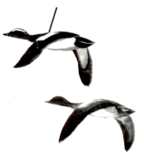 Hen
Hen
The white belly and forewing are very showy in the air. Drakes whistle; hens have a loud kaow and a lower qua-awk.
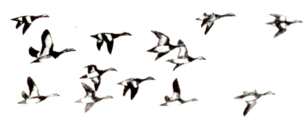 Typical Flock Pattern
Typical Flock Pattern
Length—19½"
Weight—1½ lbs.
 Hen
Hen
Shovelers, 'spoonbills' to many, are early migrants, moving out at the first frost. The largest numbers are in the Central and Pacific flyways.
The usual flight is steady and direct. When startled, the small flocks twist and turn in the air like teal.
 Hen
Drake
Hen
Drake
 Drake
Drake
 Hen
Hen
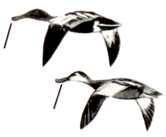 Hen
Hen
They are not highly regarded as table birds, because one third of the usual diet is animal matter.
Drakes call woh-woh and took-took; the hen's quack is feeble.
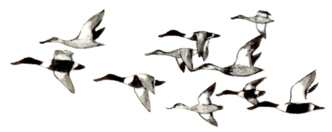 Typical Flock Pattern
Typical Flock Pattern
Length—16"
Weight—15 oz.
 Eclipse Drake
Eclipse Drake
 Hen
Hen
 Hen
Hen
Their small size and twisting turning flight gives the illusion of great speed. The small, compact flocks commonly fly low over the marshes, and often take the hunter by surprise.
They are more vocal than most ducks—their high-pitched peeping and nasal quacking is commonly heard in spring and to a lesser extent in fall.
These teal are among the first ducks to migrate each fall, and one of the last in the spring.
 Hen
Drake
Hen
Drake
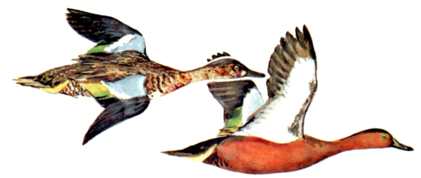 Eclipse Drake
Eclipse Drake
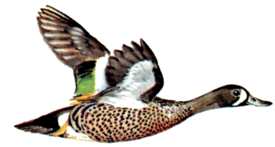 Blue-Winged Drake
Blue-Winged Drake
 Hen
Hen
 Hen
Hen
In the Pacific Flyway, cinnamon teal are far more common than blue-wings. The hens look alike and the habits of both species are similar.
The pale blue forewing patch is the best field mark, as drakes are usually in eclipse until January or longer.
Drakes have a whistling peep; hens utter a low quack.
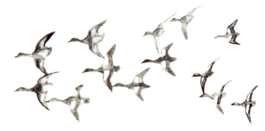 Typical Flock Pattern
Typical Flock Pattern
Length—15 in.
Weight—14 oz.
 Hen
Hen
Quite hardy—some birds stay as far north as open water is found.
The smallest and one of the most common of our ducks. Their tiny size gives the impression of great speed, but mallards can fly faster. Their flight is often low, erratic, with the entire flock twisting and turning as one unit.
 Hen
Drake
Hen
Drake
 Drake
Drake
 Hen
Hen
 Hen
Hen
They nest as far north as Alaska, and migrate in all four flyways. Early fall drakes are usually still in full eclipse plumage.
Drakes whistle and twitter; hens have a slight quack.
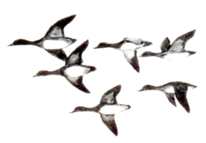 Typical Flock Pattern
Typical Flock Pattern
Length—18½ in.
Weight—1½ lbs.
 Hen
Hen
Found in all flyways; most numerous in the Atlantic and Mississippi flyways and fewest in the Central.
They are early migrants; most of them have left the northern States by mid-November.
Frequents wooded streams and ponds; perches in trees. Flies through thick timber with speed and ease and often feeds on acorns, berries, and grapes on the forest floors.
 Hen
Drake
Hen
Drake
 Drake
Drake
 Hen
Hen
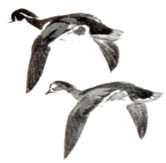 Hen
Hen
Flight is swift and direct; flocks are usually small.
In the air, their wings make a rustling, swishing sound. Drakes call hoo-w-ett, often in flight; hens have a cr-r-ek when frightened.
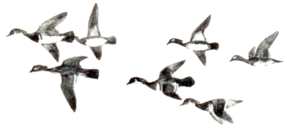 Typical Flock Pattern
Typical Flock Pattern
Length—24 in.
Weight—2¾ lbs.
 Drake
Drake
 Similar Sexes
Similar Sexes
 Typical Flock Pattern
Typical Flock Pattern
A bird of the eastern States, primarily the Atlantic Flyway and, to a lesser extent, the Mississippi.
Shy and wary, regarded as the wariest of all ducks.
Often seen in company of mallards, but along the Atlantic coast frequents the salt marshes and ocean much more than mallards.
Flight is swift, usually in small flocks.
White wing lining in contrast to very dark body plumage is a good identification clue.
The hen's quack and the drake's kwek-kwek are duplicates of the mallards.
 Hen
Drake
Hen
Drake
Diving ducks frequent the larger, deeper lakes and rivers, and coastal bays and inlets.
The colored wing patches of these birds lack the brilliance of the speculums of puddle ducks. Since many of them have short tails, their huge, paddle feet may be used as rudders in flight, and are often visible on flying birds. When launching into flight, most of this group patter along the water before becoming airborne.
They feed by diving, often to considerable depths. To escape danger, they can travel great distances underwater, emerging only enough to show their head before submerging again.
Their diets of fish, shellfish, mollusks, and aquatic plants make them second choice, as a group, for sportsmen. Canvasbacks and redheads fattened on eel grass or wild celery are notable exceptions.
Since their wings are smaller in proportion to the size and weight of their bodies, they have a more rapid wingbeat than puddle ducks.
 Feeding
Landing
Feeding
Landing
Length—22 in.
Weight—3 lbs.
 Eclipse Drake
Eclipse Drake
Normally late to start south, canvasbacks migrate in lines and irregular V's.
In feeding areas, compact flocks fly in indefinite formations. Their wingbeat is rapid and noisy; their speed is the swiftest of all our ducks.
 Hen
Drake
Hen
Drake
 Drake
Drake
 Hen
Hen
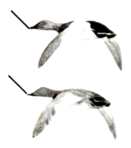 Hen
Hen
Feeding behavior is highly variable. In some areas they feed at night and spend the day rafted up in open waters; in other areas they feed inshore mornings and evenings.
On the water, body size and head shape distinguish them from scaups and redheads.
Drakes croak, peep, and growl; hens have a mallard-like quack.
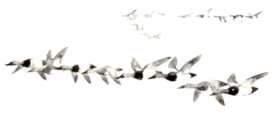 Typical Flock Pattern
Typical Flock Pattern
Length—20 in.
Weight—2½ lbs.
 Hen
Hen
Range coast to coast, with the largest numbers in the Central Flyway. Migratory flocks travel in V's; move in irregular formations over feeding areas. Often found associating with canvasback.
In the air, they give the impression of always being in a hurry.
 Hen
Drake
Hen
Drake
 Drake
Drake
 Hen
Hen
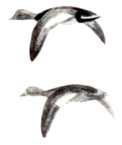 Hen
Hen
Usually spend the day in large rafts in deep water; feed morning and evening in shallower sections.
Drakes purr and meow; hens have a loud squak, higher than a hen mallard's.
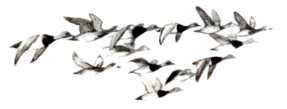 Typical Flock Pattern
Typical Flock Pattern
Length—17 in.
Weight—2½ lbs.
 Hen
Hen
Similar in appearance to scaups, but more often found in fresh marshes and wooded ponds. In flight, the dark wings are different from the white-edged wings of scaup.
Faint brown ring on drake's neck never shows in the field; light bands at tip and base of bill are conspicuous.
 Hen
Drake
Hen
Drake
 Drake
Drake
 Hen
Hen
 Hen
Hen
Fly as small flocks in open formation; often land without circling. Drakes purr; hens are usually silent.
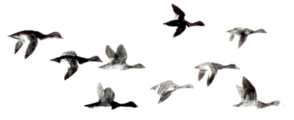 Typical Flock Pattern
Typical Flock Pattern
Greater—Length—18½ in.
Weight—2 lbs.
Lesser—Length—17 in.
Weight—1-7/8 lbs.
 Hen
Hen
 Drake
Drake
 Drake
Drake
Except for the wing marks, greater and lesser scaup appear nearly identical in the field.
The light band near the trailing edges of the wings runs almost to the tip in the greater scaup, but only about half way in the lesser.
Greater scaup prefer large open water areas; lesser scaup often use marshes and ponds.
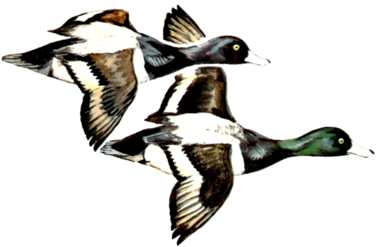 Lesser Scaup Drake
Lesser Scaup Drake
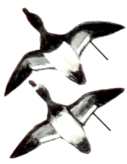 Hen
Hen
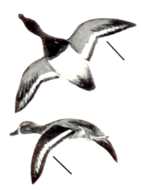 Hen
Hen
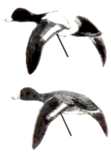 Hen
Hen
Both species migrate late, sometimes just before freezeup.
Flock movements are rapid, often erratic, usually in compact groups.
Hens are silent; drake lesser scaup purr; drake greater scaup have a discordant scaup, scaup.
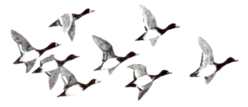 Typical Flock Pattern
Typical Flock Pattern
Common—Length—19 in.
Weight—2¼ lbs.
Barrow's—Length—19 in.
Weight—2¾ lbs.
 Common Eclipse Drake
Common Eclipse Drake
These are active, strong-winged fliers moving singly or in small flocks, often high in the air. Distinctive wing-whistling sound in flight has earned the name of whistlers.
Goldeneyes generally move south late in the season; most of them winter on coastal waters and the Great Lakes. Inland, they like rapids and fast water.
 Hen | Drake
Hen | Drake
Hen | Drake
Hen | Drake
 Common Drake
Common Drake
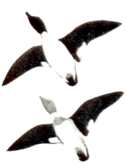 Hen
Hen
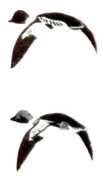 Hen
Hen
Barrow's goldeneye, predominantly a Westerner, is less wary than the common goldeneye.
Hens of both species are look-alikes.
Drakes have a piercing speer-speer—hens a low quack. Both are usually quiet.
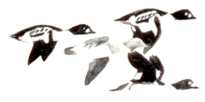 Typical Flock Pattern
Typical Flock Pattern
Length—14½ in.
Weight—1 lb.
 Eclipse Drake
Eclipse Drake
Stragglers migrate south in mid-fall, but the largest numbers move just ahead of freezeup. Most flocks in feeding areas are small—5 or 6 birds, with more hens and immatures than adult drakes.
Very small size, bold black and white color pattern, and low, swift flight are field marks. Unlike most divers, they can fly straight up from a watery takeoff.
 Hen
Drake
Hen
Drake
 Drake
Drake
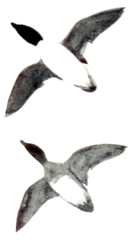 Hen
Hen
 Hen
Hen
Largest concentrations are on both seacoasts and along the Gulf of Mexico. Inland, they will remain as far north as open water permits.
Usually silent. Drakes squeak and have a guttural note; hens quack weakly.
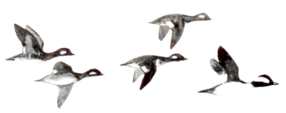 Typical Flock Pattern
Typical Flock Pattern
Length—15½ in.
Weight—1-1/3 lbs.
 Winter Drake
Hen
Winter Drake
Hen
The ruddy duck often dives or swims away from danger rather than flying. When flying, their small wings stroke so fast they resemble bumblebees.
 Sexes Similar
Sexes Similar
 Summer Drake
Summer Drake
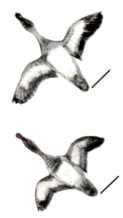 Hen
Hen
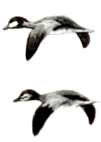 Hen
Hen
They are early to mid-fall migrants.
Drakes often cock their tails upright at an angle, the only species to habitually do so.
Both hens and drakes are silent in the fall.
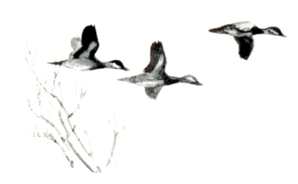 Typical Flock Pattern
Typical Flock Pattern
Length—23 in.
Weight—2½ lbs.
 Hen
Hen
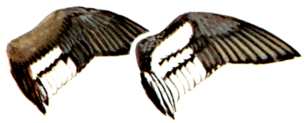 Hen
Drake
Hen
Drake
 Hen
Hen
 Hen
Hen
These birds winter most abundantly in coastal waters, including the Gulf of Mexico, and to a lesser extent, the Great Lakes.
Their flight, strong and direct, is usually low over the water. They are difficult to distinguish in flight from the common merganser.
Voice: Seldom heard.
 Typical Flock Pattern
Typical Flock Pattern
Length—25½ in.
Weight—2½ lbs.
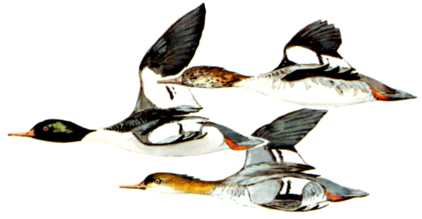 Hen
Hen
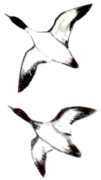 Hen
Hen
 Hen
Hen
This species is larger than the red-breasted merganser, and is one of the largest of our ducks. It is one of the last to migrate south, and is more common than the red-breasted merganser on inland waters.
Flocks move in "follow the leader" style, low over the water.
The only call seems to be a startled croak.
 Typical Flock Pattern
Typical Flock Pattern
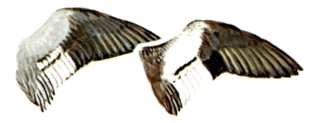 Hen and Drake Wing
Hen and Drake Wing
Length—18 in.
Weight—1½ lbs.
 Hen
Hen
 Hen
Hen
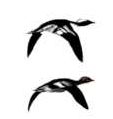 Hen
Hen
Often seen in pairs, or very small flocks. Short rapid wingstrokes create an impression of great speed.
Winters in the inland waters of all coastal States; seldom goes to salt water.
Voice: Seldom heard in fall.
 Hen
Drake
Hen
Drake
Length—18-19 in.
Weight—1¾ lbs.
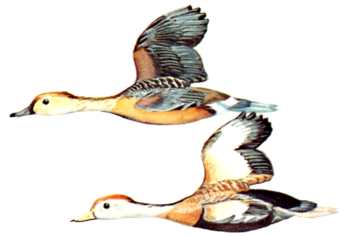 Black-Bellied
Black-Bellied
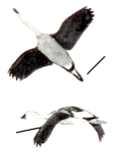 Fulvous
Fulvous
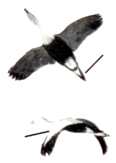 Black-Bellied
Black-Bellied
The trailing legs and rounded wings of these slow flying ducks makes them look bigger than they are.
Both species are primarily Mexican. In the U.S., the black-bellied is found only in south Texas and Louisiana. The fulvous also occurs there and in Florida with occasional stragglers further north along both coasts and the Mississippi Valley. The fulvous is the more common of the two species in the United States.
Sexes are alike. Both species have shrill whistling calls.
 Fulvous
Black-Bellied
Fulvous
Black-Bellied
Length—21½ in.
Weight—3½ lbs.
 Hen
Hen
The three scoters on these two pages are sea ducks, wintering on open coastal waters. White-wings are among the heaviest and largest of all ducks.
Length—19½ in.
Weight—2 lbs.
 Hen
Hen
Like all scoters, these birds move along our coasts in loose flocks, stringing into irregular, wavy lines. Drakes can be distinguished from other scoters by two white patches on their head and the bright color of the bill.
Flight is strong, direct, usually close to the waves.
Length—19½ in.
Weight—2½ lbs.
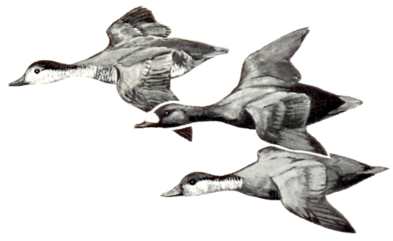 Hen
Hen
In flight, drakes appear all black except for the flash of the slight gray underwing and the bright yellow swelling at the base of the upper bill.
Scoters feed on mollusks, crabs, and some fish and very little vegetation. They are locally known as "coots."
Length—23½ in.
Weight—5 lbs.
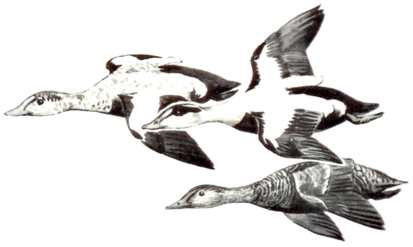 Hen
Hen
Thick-necked stocky birds, alternately flapping and sailing in flight; flocks string out in a line, close to the water. Occurs in the United States chiefly along New England coasts and occasionally south to New Jersey.
Other eiders—king, spectacled and Stellar's—occur in Alaska and are not pictured in this guide. King eiders occasionally are found in north Atlantic coastal waters.
Length—20½ in.
Weight—2 lbs.
 Winter Hen
Winter Hen
A slim, brightly plumaged sea duck. Smaller than the scoters or eiders.
Flight is swift and low with constantly changing flock formations. Ranges along both coasts and the Great Lakes.
One of the most vocal of ducks; drakes have a loud pleasant caloo, caloo, constantly heard.
Length—17 in.
Weight—1½ lbs.
 Hen
Hen
Glossy slate-blue plumage enlivened by white stripes and spots give the adult male harlequin a striking appearance. The female resembles a small female scoter. At a distance, both sexes look black. Flight is swift, with abrupt turns. Flocks are small and compact. Ranges both coasts, north from New Jersey and San Francisco. Uncommon.
Trumpeter—Length—59 in.
Weight—28 lbs.
Whistling—Length—52 in.
Weight—16 lbs.
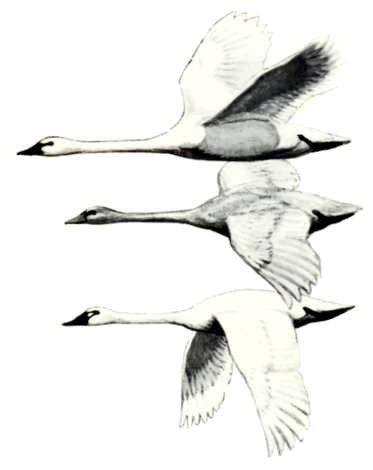 Whistling
Whistling
Once thought to be rare, trumpeter swans are slowly increasing in Alaska and on western refuges and parks.
Whistling swans are common and increasing. They winter near Chesapeake Bay, San Francisco Bay, Puget Sound and Salton Sea. Occasionally found in fields.
Both species are large with pure white plumage.

Numerous and popular, Canada geese are often called "honkers." Includes several races varying in weight from 3 to over 12 pounds. All have black heads and necks, white cheeks, similar habitats and voices. Sexes are identical.
Length—24-25 in.
Weight—3¼ - 3¾ lbs.
 Brant
Brant
These are sea geese, the blacks wintering south to Baja, California, in the Pacific. The Atlantic race winters from Virginia northward. Flight is swift, in irregular and changing flock patterns.
Length—29-31 in.
Weight—6½-7½ lbs.
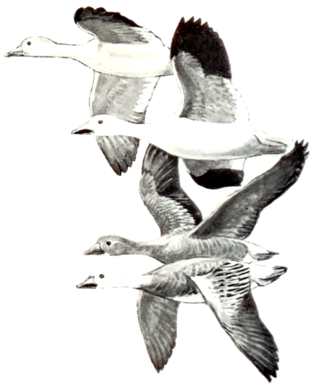 Immature Blue
Adult Blue
Immature Blue
Adult Blue
Two races of snow geese are recognized: greater snows along the Atlantic Coast, and lesser snows elsewhere on the continent. Blue geese are a color phase of the lesser snow.
Length—29 in.
Weight—6¼ lbs.
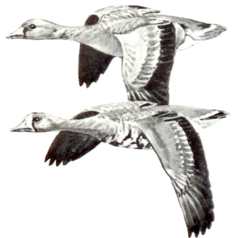 Adult
Adult
Migrates chiefly in the Central and Pacific flyways but also present in the Mississippi. Rare in the Atlantic Flyway. Appears brownish gray at a distance. Often called "specklebelly".
Most distinctive characteristic of the V-shaped flocks is the high pitched call kow-kow-kow-kow.

All birds on these pages are drawn to the same scale.

There's more than just ducks in our marshes. Knowing and identifying other birds and animals add to the enjoyment of being in a blind.
The same sources of food and shelter that draw waterfowl to ponds and marshes also attract other forms of wildlife.
Protected species are sometimes more numerous than ducks or geese.
Money from Duck Stamp sales is used exclusively to purchase wetlands, preserving areas for ducks, geese, and all wildlife for the enjoyment and pleasure of hunters and non-hunters alike.
 Ibis
Egret
Ibis
Egret
 Black Tern
Common Tern
Marsh Hawk
Black Tern
Common Tern
Marsh Hawk
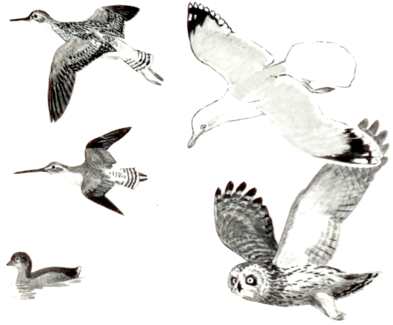 Grebe
Dowitcher
Short-Eared Owl
Grebe
Dowitcher
Short-Eared Owl
 Pacific
Central
Pacific
Central
 Mississippi
Atlantic
Mississippi
Atlantic
Waterfowl Flyways
The term "flyway" has long been used to designate the migration routes of birds. For management purposes, four waterfowl flyways—Pacific, Central, Mississippi, and Atlantic—were established in the United States in 1948. To varying degrees the waterfowl populations using each of these flyways differ in abundance, species composition, migration pathways, and breeding ground origin. There are differences, also, in levels of shooting pressure and harvest.
For the most part flyway boundaries follow State lines. However, the boundary between the Pacific and the Central flyway general follows the Continental Divide.
There are some problems in matching waterfowl migration corridors with flyway boundaries because some species nest and winter in areas that do not occur along a north-south axis. These species cross flyway boundaries during migration. On balance, the present arrangement is useful in that it permits reasonable management of waterfowl. At some future time, it is possible that further rearrangement of boundaries may permit better management of the waterfowl resource.
Flyway Councils
In 1952, Flyway Councils were formed in each of the four flyways. The Council in each flyway is made up of representatives from the wildlife agencies of the States in that flyway—one representative from each State. The Councils study flyway problems, develop waterfowl management recommendations, and generally work closely with the U.S. Fish and Wildlife Service in implementing waterfowl management and research programs.
U.S. GOVERNMENT PRINTING OFFICE: 1978 O—247-777
For sale by the Superintendent of Documents, U.S. Government Printing Office Washington, D.C. 20402
Stock No. 024-010-00442-8

Created in 1849, the Department of the Interior—America's Department of Natural Resources—is concerned with the management, conservation, and development of the Nation's water, fish, wildlife, mineral, forest, and park and recreational resources. It also has major responsibilities for Indian and Territorial affairs.
As the Nation's principal conservation agency, the Department works to assure that nonrenewable resources are developed and used wisely, that park and recreational resources are conserved for the future, and that renewable resources make their full contribution to the progress, prosperity, and security of the United States—now and in the future.
***END OF THE PROJECT GUTENBERG EBOOK DUCKS AT A DISTANCE***
******* This file should be named 18884-h.txt or 18884-h.zip *******
This and all associated files of various formats will be found in:
http://www.gutenberg.org/1/8/8/8/18884
Updated editions will replace the previous one--the old editions will be renamed.
Creating the works from public domain print editions means that no one owns a United States copyright in these works, so the Foundation (and you!) can copy and distribute it in the United States without permission and without paying copyright royalties. Special rules, set forth in the General Terms of Use part of this license, apply to copying and distributing Project Gutenberg-tm electronic works to protect the PROJECT GUTENBERG-tm concept and trademark. Project Gutenberg is a registered trademark, and may not be used if you charge for the eBooks, unless you receive specific permission. If you do not charge anything for copies of this eBook, complying with the rules is very easy. You may use this eBook for nearly any purpose such as creation of derivative works, reports, performances and research. They may be modified and printed and given away--you may do practically ANYTHING with public domain eBooks. Redistribution is subject to the trademark license, especially commercial redistribution.
*** START: FULL LICENSE ***
THE FULL PROJECT GUTENBERG LICENSE
PLEASE READ THIS BEFORE YOU DISTRIBUTE OR USE THIS WORK
To protect the Project Gutenberg-tm mission of promoting the free
distribution of electronic works, by using or distributing this work
(or any other work associated in any way with the phrase "Project
Gutenberg"), you agree to comply with all the terms of the Full Project
Gutenberg-tm License (available with this file or online at
http://www.gutenberg.org/license).
Section 1. General Terms of Use and Redistributing Project Gutenberg-tm
electronic works
1.A. By reading or using any part of this Project Gutenberg-tm
electronic work, you indicate that you have read, understand, agree to
and accept all the terms of this license and intellectual property
(trademark/copyright) agreement. If you do not agree to abide by all
the terms of this agreement, you must cease using and return or destroy
all copies of Project Gutenberg-tm electronic works in your possession.
If you paid a fee for obtaining a copy of or access to a Project
Gutenberg-tm electronic work and you do not agree to be bound by the
terms of this agreement, you may obtain a refund from the person or
entity to whom you paid the fee as set forth in paragraph 1.E.8.
1.B. "Project Gutenberg" is a registered trademark. It may only be
used on or associated in any way with an electronic work by people who
agree to be bound by the terms of this agreement. There are a few
things that you can do with most Project Gutenberg-tm electronic works
even without complying with the full terms of this agreement. See
paragraph 1.C below. There are a lot of things you can do with Project
Gutenberg-tm electronic works if you follow the terms of this agreement
and help preserve free future access to Project Gutenberg-tm electronic
works. See paragraph 1.E below.
1.C. The Project Gutenberg Literary Archive Foundation ("the Foundation"
or PGLAF), owns a compilation copyright in the collection of Project
Gutenberg-tm electronic works. Nearly all the individual works in the
collection are in the public domain in the United States. If an
individual work is in the public domain in the United States and you are
located in the United States, we do not claim a right to prevent you from
copying, distributing, performing, displaying or creating derivative
works based on the work as long as all references to Project Gutenberg
are removed. Of course, we hope that you will support the Project
Gutenberg-tm mission of promoting free access to electronic works by
freely sharing Project Gutenberg-tm works in compliance with the terms of
this agreement for keeping the Project Gutenberg-tm name associated with
the work. You can easily comply with the terms of this agreement by
keeping this work in the same format with its attached full Project
Gutenberg-tm License when you share it without charge with others.
1.D. The copyright laws of the place where you are located also govern
what you can do with this work. Copyright laws in most countries are in
a constant state of change. If you are outside the United States, check
the laws of your country in addition to the terms of this agreement
before downloading, copying, displaying, performing, distributing or
creating derivative works based on this work or any other Project
Gutenberg-tm work. The Foundation makes no representations concerning
the copyright status of any work in any country outside the United
States.
1.E. Unless you have removed all references to Project Gutenberg:
1.E.1. The following sentence, with active links to, or other immediate
access to, the full Project Gutenberg-tm License must appear prominently
whenever any copy of a Project Gutenberg-tm work (any work on which the
phrase "Project Gutenberg" appears, or with which the phrase "Project
Gutenberg" is associated) is accessed, displayed, performed, viewed,
copied or distributed:
This eBook is for the use of anyone anywhere at no cost and with
almost no restrictions whatsoever. You may copy it, give it away or
re-use it under the terms of the Project Gutenberg License included
with this eBook or online at www.gutenberg.org
1.E.2. If an individual Project Gutenberg-tm electronic work is derived
from the public domain (does not contain a notice indicating that it is
posted with permission of the copyright holder), the work can be copied
and distributed to anyone in the United States without paying any fees
or charges. If you are redistributing or providing access to a work
with the phrase "Project Gutenberg" associated with or appearing on the
work, you must comply either with the requirements of paragraphs 1.E.1
through 1.E.7 or obtain permission for the use of the work and the
Project Gutenberg-tm trademark as set forth in paragraphs 1.E.8 or
1.E.9.
1.E.3. If an individual Project Gutenberg-tm electronic work is posted
with the permission of the copyright holder, your use and distribution
must comply with both paragraphs 1.E.1 through 1.E.7 and any additional
terms imposed by the copyright holder. Additional terms will be linked
to the Project Gutenberg-tm License for all works posted with the
permission of the copyright holder found at the beginning of this work.
1.E.4. Do not unlink or detach or remove the full Project Gutenberg-tm
License terms from this work, or any files containing a part of this
work or any other work associated with Project Gutenberg-tm.
1.E.5. Do not copy, display, perform, distribute or redistribute this
electronic work, or any part of this electronic work, without
prominently displaying the sentence set forth in paragraph 1.E.1 with
active links or immediate access to the full terms of the Project
Gutenberg-tm License.
1.E.6. You may convert to and distribute this work in any binary,
compressed, marked up, nonproprietary or proprietary form, including any
word processing or hypertext form. However, if you provide access to or
distribute copies of a Project Gutenberg-tm work in a format other than
"Plain Vanilla ASCII" or other format used in the official version
posted on the official Project Gutenberg-tm web site (www.gutenberg.org),
you must, at no additional cost, fee or expense to the user, provide a
copy, a means of exporting a copy, or a means of obtaining a copy upon
request, of the work in its original "Plain Vanilla ASCII" or other
form. Any alternate format must include the full Project Gutenberg-tm
License as specified in paragraph 1.E.1.
1.E.7. Do not charge a fee for access to, viewing, displaying,
performing, copying or distributing any Project Gutenberg-tm works
unless you comply with paragraph 1.E.8 or 1.E.9.
1.E.8. You may charge a reasonable fee for copies of or providing
access to or distributing Project Gutenberg-tm electronic works provided
that
- You pay a royalty fee of 20% of the gross profits you derive from
the use of Project Gutenberg-tm works calculated using the method
you already use to calculate your applicable taxes. The fee is
owed to the owner of the Project Gutenberg-tm trademark, but he
has agreed to donate royalties under this paragraph to the
Project Gutenberg Literary Archive Foundation. Royalty payments
must be paid within 60 days following each date on which you
prepare (or are legally required to prepare) your periodic tax
returns. Royalty payments should be clearly marked as such and
sent to the Project Gutenberg Literary Archive Foundation at the
address specified in Section 4, "Information about donations to
the Project Gutenberg Literary Archive Foundation."
- You provide a full refund of any money paid by a user who notifies
you in writing (or by e-mail) within 30 days of receipt that s/he
does not agree to the terms of the full Project Gutenberg-tm
License. You must require such a user to return or
destroy all copies of the works possessed in a physical medium
and discontinue all use of and all access to other copies of
Project Gutenberg-tm works.
- You provide, in accordance with paragraph 1.F.3, a full refund of any
money paid for a work or a replacement copy, if a defect in the
electronic work is discovered and reported to you within 90 days
of receipt of the work.
- You comply with all other terms of this agreement for free
distribution of Project Gutenberg-tm works.
1.E.9. If you wish to charge a fee or distribute a Project Gutenberg-tm
electronic work or group of works on different terms than are set
forth in this agreement, you must obtain permission in writing from
both the Project Gutenberg Literary Archive Foundation and Michael
Hart, the owner of the Project Gutenberg-tm trademark. Contact the
Foundation as set forth in Section 3 below.
1.F.
1.F.1. Project Gutenberg volunteers and employees expend considerable
effort to identify, do copyright research on, transcribe and proofread
public domain works in creating the Project Gutenberg-tm
collection. Despite these efforts, Project Gutenberg-tm electronic
works, and the medium on which they may be stored, may contain
"Defects," such as, but not limited to, incomplete, inaccurate or
corrupt data, transcription errors, a copyright or other intellectual
property infringement, a defective or damaged disk or other medium, a
computer virus, or computer codes that damage or cannot be read by
your equipment.
1.F.2. LIMITED WARRANTY, DISCLAIMER OF DAMAGES - Except for the "Right
of Replacement or Refund" described in paragraph 1.F.3, the Project
Gutenberg Literary Archive Foundation, the owner of the Project
Gutenberg-tm trademark, and any other party distributing a Project
Gutenberg-tm electronic work under this agreement, disclaim all
liability to you for damages, costs and expenses, including legal
fees. YOU AGREE THAT YOU HAVE NO REMEDIES FOR NEGLIGENCE, STRICT
LIABILITY, BREACH OF WARRANTY OR BREACH OF CONTRACT EXCEPT THOSE
PROVIDED IN PARAGRAPH F3. YOU AGREE THAT THE FOUNDATION, THE
TRADEMARK OWNER, AND ANY DISTRIBUTOR UNDER THIS AGREEMENT WILL NOT BE
LIABLE TO YOU FOR ACTUAL, DIRECT, INDIRECT, CONSEQUENTIAL, PUNITIVE OR
INCIDENTAL DAMAGES EVEN IF YOU GIVE NOTICE OF THE POSSIBILITY OF SUCH
DAMAGE.
1.F.3. LIMITED RIGHT OF REPLACEMENT OR REFUND - If you discover a
defect in this electronic work within 90 days of receiving it, you can
receive a refund of the money (if any) you paid for it by sending a
written explanation to the person you received the work from. If you
received the work on a physical medium, you must return the medium with
your written explanation. The person or entity that provided you with
the defective work may elect to provide a replacement copy in lieu of a
refund. If you received the work electronically, the person or entity
providing it to you may choose to give you a second opportunity to
receive the work electronically in lieu of a refund. If the second copy
is also defective, you may demand a refund in writing without further
opportunities to fix the problem.
1.F.4. Except for the limited right of replacement or refund set forth
in paragraph 1.F.3, this work is provided to you 'AS-IS,' WITH NO OTHER
WARRANTIES OF ANY KIND, EXPRESS OR IMPLIED, INCLUDING BUT NOT LIMITED TO
WARRANTIES OF MERCHANTIBILITY OR FITNESS FOR ANY PURPOSE.
1.F.5. Some states do not allow disclaimers of certain implied
warranties or the exclusion or limitation of certain types of damages.
If any disclaimer or limitation set forth in this agreement violates the
law of the state applicable to this agreement, the agreement shall be
interpreted to make the maximum disclaimer or limitation permitted by
the applicable state law. The invalidity or unenforceability of any
provision of this agreement shall not void the remaining provisions.
1.F.6. INDEMNITY - You agree to indemnify and hold the Foundation, the
trademark owner, any agent or employee of the Foundation, anyone
providing copies of Project Gutenberg-tm electronic works in accordance
with this agreement, and any volunteers associated with the production,
promotion and distribution of Project Gutenberg-tm electronic works,
harmless from all liability, costs and expenses, including legal fees,
that arise directly or indirectly from any of the following which you do
or cause to occur: (a) distribution of this or any Project Gutenberg-tm
work, (b) alteration, modification, or additions or deletions to any
Project Gutenberg-tm work, and (c) any Defect you cause.
Section 2. Information about the Mission of Project Gutenberg-tm
Project Gutenberg-tm is synonymous with the free distribution of
electronic works in formats readable by the widest variety of computers
including obsolete, old, middle-aged and new computers. It exists
because of the efforts of hundreds of volunteers and donations from
people in all walks of life.
Volunteers and financial support to provide volunteers with the
assistance they need, is critical to reaching Project Gutenberg-tm's
goals and ensuring that the Project Gutenberg-tm collection will
remain freely available for generations to come. In 2001, the Project
Gutenberg Literary Archive Foundation was created to provide a secure
and permanent future for Project Gutenberg-tm and future generations.
To learn more about the Project Gutenberg Literary Archive Foundation
and how your efforts and donations can help, see Sections 3 and 4
and the Foundation web page at http://www.gutenberg.org/fundraising/pglaf.
Section 3. Information about the Project Gutenberg Literary Archive
Foundation
The Project Gutenberg Literary Archive Foundation is a non profit
501(c)(3) educational corporation organized under the laws of the
state of Mississippi and granted tax exempt status by the Internal
Revenue Service. The Foundation's EIN or federal tax identification
number is 64-6221541. Contributions to the Project Gutenberg
Literary Archive Foundation are tax deductible to the full extent
permitted by U.S. federal laws and your state's laws.
The Foundation's principal office is located at 4557 Melan Dr. S.
Fairbanks, AK, 99712., but its volunteers and employees are scattered
throughout numerous locations. Its business office is located at
809 North 1500 West, Salt Lake City, UT 84116, (801) 596-1887, email
business@pglaf.org. Email contact links and up to date contact
information can be found at the Foundation's web site and official
page at http://www.gutenberg.org/about/contact
For additional contact information:
Dr. Gregory B. Newby
Chief Executive and Director
gbnewby@pglaf.org
Section 4. Information about Donations to the Project Gutenberg
Literary Archive Foundation
Project Gutenberg-tm depends upon and cannot survive without wide
spread public support and donations to carry out its mission of
increasing the number of public domain and licensed works that can be
freely distributed in machine readable form accessible by the widest
array of equipment including outdated equipment. Many small donations
($1 to $5,000) are particularly important to maintaining tax exempt
status with the IRS.
The Foundation is committed to complying with the laws regulating
charities and charitable donations in all 50 states of the United
States. Compliance requirements are not uniform and it takes a
considerable effort, much paperwork and many fees to meet and keep up
with these requirements. We do not solicit donations in locations
where we have not received written confirmation of compliance. To
SEND DONATIONS or determine the status of compliance for any
particular state visit http://www.gutenberg.org/fundraising/pglaf
While we cannot and do not solicit contributions from states where we
have not met the solicitation requirements, we know of no prohibition
against accepting unsolicited donations from donors in such states who
approach us with offers to donate.
International donations are gratefully accepted, but we cannot make
any statements concerning tax treatment of donations received from
outside the United States. U.S. laws alone swamp our small staff.
Please check the Project Gutenberg Web pages for current donation
methods and addresses. Donations are accepted in a number of other
ways including checks, online payments and credit card donations.
To donate, please visit: http://www.gutenberg.org/fundraising/donate
Section 5. General Information About Project Gutenberg-tm electronic
works.
Professor Michael S. Hart is the originator of the Project Gutenberg-tm
concept of a library of electronic works that could be freely shared
with anyone. For thirty years, he produced and distributed Project
Gutenberg-tm eBooks with only a loose network of volunteer support.
Project Gutenberg-tm eBooks are often created from several printed
editions, all of which are confirmed as Public Domain in the U.S.
unless a copyright notice is included. Thus, we do not necessarily
keep eBooks in compliance with any particular paper edition.
Each eBook is in a subdirectory of the same number as the eBook's
eBook number, often in several formats including plain vanilla ASCII,
compressed (zipped), HTML and others.
Corrected EDITIONS of our eBooks replace the old file and take over
the old filename and etext number. The replaced older file is renamed.
VERSIONS based on separate sources are treated as new eBooks receiving
new filenames and etext numbers.
Most people start at our Web site which has the main PG search facility:
http://www.gutenberg.org
This Web site includes information about Project Gutenberg-tm,
including how to make donations to the Project Gutenberg Literary
Archive Foundation, how to help produce our new eBooks, and how to
subscribe to our email newsletter to hear about new eBooks.
EBooks posted prior to November 2003, with eBook numbers BELOW #10000,
are filed in directories based on their release date. If you want to
download any of these eBooks directly, rather than using the regular
search system you may utilize the following addresses and just
download by the etext year.
http://www.gutenberg.org/dirs/etext06/
(Or /etext 05, 04, 03, 02, 01, 00, 99,
98, 97, 96, 95, 94, 93, 92, 92, 91 or 90)
EBooks posted since November 2003, with etext numbers OVER #10000, are
filed in a different way. The year of a release date is no longer part
of the directory path. The path is based on the etext number (which is
identical to the filename). The path to the file is made up of single
digits corresponding to all but the last digit in the filename. For
example an eBook of filename 10234 would be found at:
http://www.gutenberg.org/dirs/1/0/2/3/10234
or filename 24689 would be found at:
http://www.gutenberg.org/dirs/2/4/6/8/24689
An alternative method of locating eBooks:
http://www.gutenberg.org/dirs/GUTINDEX.ALL
*** END: FULL LICENSE ***